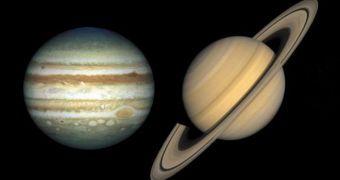Back when the solar system was still in its infancy, and the Sun was only a shadow of what it was to become, one of our gas giant planets played an important role in determining the ultimate appearance of the system, and potentially Earth's chances of supporting life. That planet was Jupiter.
For billions of years, the massive gaseous planet has been the fifth from the Sun, but things weren't always set up this way. At one point, the massive object got so close to its parent star, that it reached the orbit now occupied by Mars, our neighboring planet.
Apparently, the process continued for millions of years. Jupiter alternatively moved towards the inner solar system, and then back out again, reaching various degrees of proximity to the Sun. Experts now believe that the object's proximity is one of the reasons why Mars is now so small.
These travels generated a massive ripple effect on the solar system, forcing the Inner Asteroid Belt to rearrange and reorganize itself in response to the tremendous gravitational influences that the gas giant exerted on them.
“We refer to Jupiter's path as the Grand Tack, because the big theme in this work is Jupiter migrating toward the sun and then stopping, turning around, and migrating back outward,” explains Kevin Walsh.
“This change in direction is like the course that a sailboat takes when it tacks around a buoy,” adds the scientist, who is the first first author of a new paper detailing the findings. The work appears in the june 5 issue of the top scientific journal Nature.
Walsh is based at the Southwest Research Institute (SwRI), in Boulder, Colorado, which is one of the organizations taking part in the international collaboration that carrier out the research. The group included experts with the NASA Goddard Space Flight Center (GSFC), in Greenbelt, Maryland.
The new models of the solar system the team compiled indicate that the planet formed some 3.5 astronomical units (AU) from the Sun, But was caught in strong currents of gas, which carried it all over the place. At that time, the solar system was still filled with massive volumes of gas.
Over the years, Saturn joined Jupiter in its slow inward spiral but, as the gas was slowly disappearing from the solar system, the motion eventually stopped. After a while, the movement was reversed, and the planet claimed the spots we've come to know them in.
“Jupiter migrating in and then all the way back out again can solve the long-standing mystery of why the asteroid belt is made up of both dry, rocky objects and icy objects,” explains GSFC planetary scientist and study coauthor Avi Mandell.
“Knowing that our own planets moved around a lot in the past makes our solar system much more like our neighbors than we previously thought. We're not an outlier anymore,” Walsh concludes.

 14 DAY TRIAL //
14 DAY TRIAL //